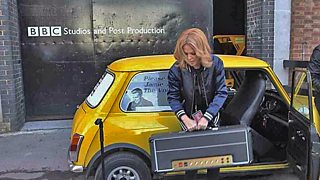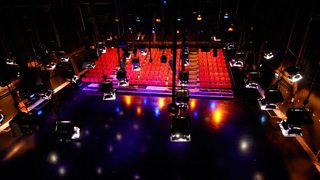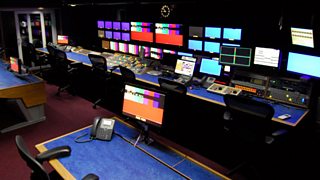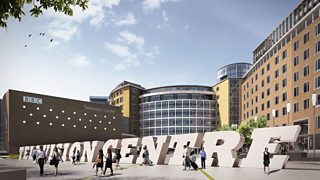Relocating �������� Studios and Post Production
Danny Popkin
Technical Development Manager, �������� Studios and Post Production
Tagged with:

is a commercial subsidiary of the �������� which provides studios, post production and digital media services to the broadcast industry. In this post, technical development manager Danny Popkin writes about his work on one of the biggest projects he’s been involved with at �������� S&PP.
I am in charge of studio technology projects at �������� S&PP, including technology upgrades or moves. In this post, I wanted to explain how we've gone about moving equipment and services from Television Centre to Elstree, and give a sense of what's on offer to the �������� and other production companies and broadcasters at our new base.
Why we refurbish studios
First though, it's worth explaining some things about our work which may come as a surprise to some. Television studios don't maintain themselves and given that they are a part of a fast-moving technological environment, they're frequently in need of refurbishment and technical upgrades. This was the case at Television Centre where we were refreshing, on average, one studio every year. Across 8 studios it was about a 7-year cycle of partial or complete refurbishment. On top of that were standard upgrades and change of technology - for example, the movement from tape to disc-based technology or the move to different IT systems. Over the 30 years I've been involved in TV, we've moved from 4:3 to 'widescreen', standard definition to HD for example. Originally everything captured in a TV studio could be sent easily down half a mile of copper wire. As we've moved to digital and now HD, the capacity of those copper cable links have got shorter and shorter. We can't send it down the same length and expect it to come out the other end. So even that core element – the copper ‘wire’ has had to be upgraded to something which is fit for purpose.
For many years the �������� had to develop its own technology and the �������� used to have departments that would build and test things. The expansion of the media market and the consumerisation of goods has meant the �������� doesn't have to do that anymore. Commercial organisations are developing new technology all the time. All we have to do is buy the equipment based on our need and what’s best for us. In that way, we have to follow fairly rapidly the movements of manufacturers because the organisation wants to get the benefits of efficiencies the industry can provide us with. �������� Studios and Post Production has been recognised as being at the forefront of that for the �������� over many years – it’s an important part of our work for our clients.
Moving to Elstree
Last year when �������� Television Centre was closed for redevelopment, and our longer-term return to a refurbished TVC, to re-open Studios 1-3.
We already had a base at �������� Elstree - it’s where we provide studios and post production services for EastEnders and operate our Elstree Studio D, similar in size to Studio 1 at Television Centre and home to shows like Sky’s A League of their Own, which we make for CPL Productions.
Whilst Television Centre is being redeveloped, we needed to find new studio spaces to offer our production customers, so we approached Elstree Studios across the road and it was agreed that we would run Stage 8, Stage 9 and at times the enormous George Lucas stages. Stage 8 and Stage 9 were effectively film stages, built in the 1960s and they had barely had anything done to them since, so would require considerable work to get them ready for our TV clients.

The refurbished Stage 8 at Elstree
Fast refurbishment – turning film stages into TV studios
I was heavily involved in the move from TVC to Elstree and the upgrade of our new site.�� It was the single biggest project I've been involved in, one which was completed relatively cheaply and really quite fast. But it was a project which came with some unusual demands. For example, we didn't get formal confirmation that TVC was closing until about nine months before it actually shut. Although we'd done some preliminary work on plans for the move, we couldn't get cracking on the rest of it until we knew for sure that we were leaving and when that would be. Once we knew, we started in earnest in August 2012. The budgets were roughly set very quickly and we were underway.
Unfurnished film stages (like Stage 8 and Stage 9 that we were moving into) are effectively just empty boxes and have nothing in them. They also tend to have wooden floors. We needed to upgrade the floors so TV cameras could run smoothly over the top. Lights and hoists needed fitting out too (film stages tend to light scenes from the floor up, whereas TV studios light from the ceiling down), so we needed to install what we call a ‘saturated lighting grid’. We decided to make use of a monopole hoist system (this helps us easily flex the lighting arrangement, and turn studios around faster in between productions) but that in itself meant that hardware needed sourcing to kit out the studio. Additionally and very importantly we needed to install TV production galleries (film stages don’t have these installed!).
We worked in partnership with , who co-funded the works, which also included improving facilities for production teams and talent – for example refurbishing dressing rooms, green rooms and production office space.
At the same time as the Elstree Studios refurbishment works, we also upgraded our own �������� Elstree Studio D to support large live event shows such as and most recently �������� News election 2014 coverage.

Election coverage at �������� Elstree
How we’ve re-used equipment
In terms of equipment we decided to basically lift and shift production galleries and technical kit from TVC to Elstree.�� Most of the equipment was moved apart from our ageing glass monitors and SD kit, so that made us entirely flat screen and fully HD, bringing the spec of the equipment production staff could use really up to date. We re-used equipment wherever possible - we brought a number of gallery desks with us for example and reassembled them at Elstree and we even brought across make-up mirrors and the dressing room key fob system! We also used the move as an opportunity to enhance the systems as well, standardising our system layouts and configurations making it easier to move staff between stages, and simpler for freelance staff to understand. All of our sound galleries now boast the same Studer Vista 8 desks, upgraded to the latest hardware and OS, utilising stageboxes to minimise studio box wiring.
For me, one of the most impressive elements about the project was the speed at which we worked. We had confirmation that the move would go ahead in summer 2012 and �������� Studios and Post Production was fully up and running in Elstree by March 2013 at the same time as maintaining studio services at Television Centre right up until it closed, making shows like Friday Night with Jonathan Ross, When Miranda Met Bruce and Madness Live: Goodbye Television Centre. We sometimes take these things for granted, but in short, that’s running three different studio sites, with a limited staff base, while two of them are going through significant refurbishment and the other is gradually closing down. No easy feat!

New HD production galleries
A few months after we were up and running at Elstree Studios, we also installed new HD production galleries alongside the George Lucas Stage 1 and 2 – making it the biggest studio space in Europe with permanent HD galleries. It’s since successfully hosted big entertainment shows like Strictly Come Dancing and The Voice.
With all of the refurbishment works, by using our own in-house technical and engineering expertise we were able to repurpose and reuse technology and equipment from Television Centre and save on cost.
What programme makers say
Moving to Elstree was unlike anything else we’d delivered in my time at the ��������. What was essential was lots of planning and a pragmatic approach in order to carry it through. This resourcefulness is something Anna picked up in her blog post in Christmas of last year.
It’s been a big success though. Since we started operating here, we have supported over 45 different programme titles, including shows like Pointless, Children in Need, ITV’s The Chase and even Channel 4’s Winter Paralympics coverage, which amounted to nearly 80 hours!
You can hear from Pointless Series Producer John Ryan about his experiences at Elstree in this short video.
John Ryan, Series Producer of Pointless talks about the show's move from TVC to Elstree
Returning to Television Centre
Looking ahead, we’ll be going back to three studios at Television Centre and I’m looking after the technical fit out for that.

The priority that remains for us is to install equipment which is, as far as we possibly can make it, future-proofed. So, another important part of my work is to look carefully at the industry and see where the trends are going and what's going to get bigger - for example, 4K (or correctly Ultra High Definition TV). Future generations of TVs will be considerably 'more' than the current 4K, offering the viewer a far better experience than just more pixels, with better colour rendition, higher dynamic range and higher frame rates as well as smart TV features. So anything we buy in will need to take into account that increased consumer need. We’ll also need to think about how we’ll deliver UHDTV in the future. The industry hasn’t as yet settled on a solution for that yet, but when it has �������� Studios and Post Production will be there, making sure we’re making the very best available for our clients and for the audience.
Danny Popkin is Technical Development Manager, �������� Studios and Post Production.
��
For more information please visit the .
